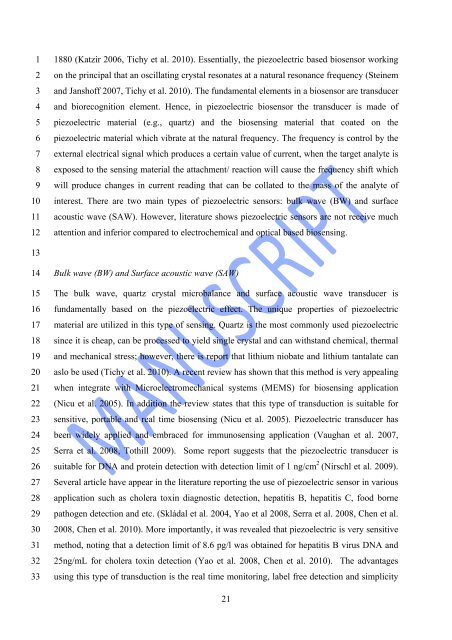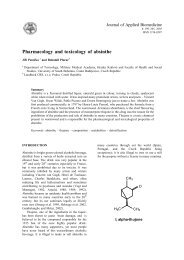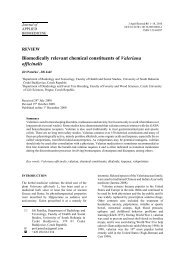Advances in biosensors: principle, architecture and applications
Advances in biosensors: principle, architecture and applications
Advances in biosensors: principle, architecture and applications
Create successful ePaper yourself
Turn your PDF publications into a flip-book with our unique Google optimized e-Paper software.
1<br />
2<br />
3<br />
4<br />
5<br />
6<br />
7<br />
8<br />
9<br />
10<br />
11<br />
12<br />
13<br />
14<br />
15<br />
16<br />
17<br />
18<br />
19<br />
20<br />
21<br />
22<br />
23<br />
24<br />
25<br />
26<br />
27<br />
28<br />
29<br />
30<br />
31<br />
32<br />
33<br />
1880 (Katzir 2006, Tichy et al. 2010). Essentially, the piezoelectric based biosensor work<strong>in</strong>g<br />
on the pr<strong>in</strong>cipal that an oscillat<strong>in</strong>g crystal resonates at a natural resonance frequency (Ste<strong>in</strong>em<br />
<strong>and</strong> Janshoff 2007, Tichy et al. 2010). The fundamental elements <strong>in</strong> a biosensor are transducer<br />
<strong>and</strong> biorecognition element. Hence, <strong>in</strong> piezoelectric biosensor the transducer is made of<br />
piezoelectric material (e.g., quartz) <strong>and</strong> the biosens<strong>in</strong>g material that coated on the<br />
piezoelectric material which vibrate at the natural frequency. The frequency is control by the<br />
external electrical signal which produces a certa<strong>in</strong> value of current, when the target analyte is<br />
exposed to the sens<strong>in</strong>g material the attachment/ reaction will cause the frequency shift which<br />
will produce changes <strong>in</strong> current read<strong>in</strong>g that can be collated to the mass of the analyte of<br />
<strong>in</strong>terest. There are two ma<strong>in</strong> types of piezoelectric sensors: bulk wave (BW) <strong>and</strong> surface<br />
acoustic wave (SAW). However, literature shows piezoelectric sensors are not receive much<br />
attention <strong>and</strong> <strong>in</strong>ferior compared to electrochemical <strong>and</strong> optical based biosens<strong>in</strong>g.<br />
Bulk wave (BW) <strong>and</strong> Surface acoustic wave (SAW)<br />
The bulk wave, quartz crystal microbalance <strong>and</strong> surface acoustic wave transducer is<br />
fundamentally based on the piezoelectric effect. The unique properties of piezoelectric<br />
material are utilized <strong>in</strong> this type of sens<strong>in</strong>g. Quartz is the most commonly used piezoelectric<br />
s<strong>in</strong>ce it is cheap, can be processed to yield s<strong>in</strong>gle crystal <strong>and</strong> can withst<strong>and</strong> chemical, thermal<br />
<strong>and</strong> mechanical stress; however, there is report that lithium niobate <strong>and</strong> lithium tantalate can<br />
aslo be used (Tichy et al. 2010). A recent review has shown that this method is very appeal<strong>in</strong>g<br />
when <strong>in</strong>tegrate with Microelectromechanical systems (MEMS) for biosens<strong>in</strong>g application<br />
(Nicu et al. 2005). In addition the review states that this type of transduction is suitable for<br />
sensitive, portable <strong>and</strong> real time biosens<strong>in</strong>g (Nicu et al. 2005). Piezoelectric transducer has<br />
been widely applied <strong>and</strong> embraced for immunosens<strong>in</strong>g application (Vaughan et al. 2007,<br />
Serra et al. 2008, Tothill 2009). Some report suggests that the piezoelectric transducer is<br />
suitable for DNA <strong>and</strong> prote<strong>in</strong> detection with detection limit of 1 ng/cm 2 (Nirschl et al. 2009).<br />
Several article have appear <strong>in</strong> the literature report<strong>in</strong>g the use of piezoelectric sensor <strong>in</strong> various<br />
application such as cholera tox<strong>in</strong> diagnostic detection, hepatitis B, hepatitis C, food borne<br />
pathogen detection <strong>and</strong> etc. (Skládal et al. 2004, Yao et al 2008, Serra et al. 2008, Chen et al.<br />
2008, Chen et al. 2010). More importantly, it was revealed that piezoelectric is very sensitive<br />
method, not<strong>in</strong>g that a detection limit of 8.6 pg/l was obta<strong>in</strong>ed for hepatitis B virus DNA <strong>and</strong><br />
25ng/mL for cholera tox<strong>in</strong> detection (Yao et al. 2008, Chen et al. 2010). The advantages<br />
us<strong>in</strong>g this type of transduction is the real time monitor<strong>in</strong>g, label free detection <strong>and</strong> simplicity<br />
21





